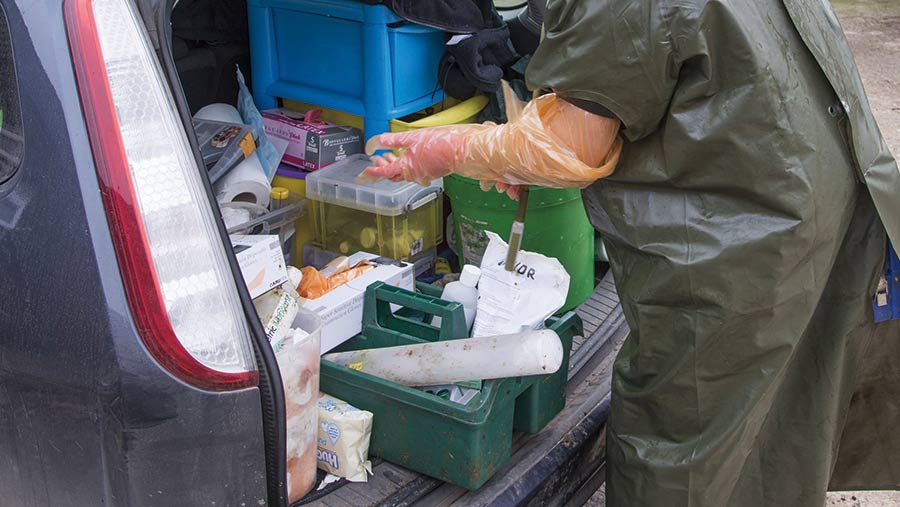Vet Viewpoint: lambing, calving and post-Brexit drug stocks
 © FLPA/John Eveson/REX/Shutterstock
© FLPA/John Eveson/REX/Shutterstock Unsurprisingly, at this time of year, vets across the UK are talking about lambing and calving.
Topics in this month’s round-up include disease prevention through metabolic profiling through to managing issues and staying on top of pain relief.
A topic not usually on the agenda for March though is the supply of medicines around Brexit. Jonathan Stockton from Yorkshire explains how they have been considering what to do about stocks.
Ed Hill
Thrums Veterinary Group, Kirriemuir, Angus
 This time of year sees the majority of our sheep flocks gearing up for lambing and one important intervention we often make with flocks is to perform a “metabolic profile” on a small number of expectant ewes.
This time of year sees the majority of our sheep flocks gearing up for lambing and one important intervention we often make with flocks is to perform a “metabolic profile” on a small number of expectant ewes.
This involves taking bloods to assess the adequacy of their diet, in particular the energy and protein provision.
See also: 16 ways to reduce lamb mortality
By performing the metabolic profile two to three weeks prior to the onset of lambing, vital information can be obtained that allows dietary adjustments to be made if required.
Ensuring energy levels are appropriate avoids issues such as twin lamb disease. Adequate protein levels ensure that colostrum will be present in high quality and quantity, which in turn will optimise lamb survival.
Performing a metabolic profile is quick and cheap, so be sure to speak to your vet about it in the run up to lambing this year.
Jonathan Stockton
Craven Farm Vets, Skipton, Yorkshire
 With all the concerns over Brexit we have been considering what to do regarding our own medicine stocks.
With all the concerns over Brexit we have been considering what to do regarding our own medicine stocks.
We have enquired of the major manufacturers as to what plans they have put in place.
UK manufacturers have been stockpiling raw materials for some time and others have been moving larger amounts of product than normal into the UK, just in case there are issues at the border post-Brexit.
We have also looked at what products we use regularly and what alternatives there are to them. As it happens, there are very few actual novel products that we can’t substitute with a genuine generic or one that is slightly different in the actives and/or withdrawal periods.
All this suggests that in the short term there is unlikely to be a shortage of product as long as farmers are willing to be flexible.
Dominic Alexander
Belmont Farm & Equine Vets, Hereford, Herefordshire
 Lambing is getting under way here and, touch wood, we haven’t seen too many problems so far.
Lambing is getting under way here and, touch wood, we haven’t seen too many problems so far.
One of the great advances in farm animal medicine has been the growing awareness of animal pain and the corresponding use of painkillers/anti-inflammatories.
If a ewe or a cow has had a difficult lambing or calving, administer a painkiller sooner rather than later – even if the animal does not appear to be in pain.
It is easier to reduce pain if you get ahead of it. Once pain builds, it is harder to get under control.
Like many XLVet practices we have been running Mastering Medicines courses. In these, we try to develop an understanding of not only what the medicines do but how they work and, importantly, the timing of their use.
Max Hardy
Farm Veterinary Solutions, Melton Mowbray, Leicestershire
 In spring block-calving dairy herds, we commonly start to see problems six weeks in, such as more downer cows, assisted calvings and metabolic diseases.
In spring block-calving dairy herds, we commonly start to see problems six weeks in, such as more downer cows, assisted calvings and metabolic diseases.
Feeding high volumes of drier forage-based rations to dry cows through January and February controls dietary calcium, energy and protein. However, if late calvers remain housed, body reserves can become depleted.
Monitor cows closely and if body condition score (BCS) is decreasing, supplement forage with dry cow concentrates.
If the mild spring continues, many late dry cows will be turned out: ensure magnesium levels are high, monitor condition, and if BCS is increasing then limit grazing and/or supplement with straw.
Due to the risk of milk fever, I advise holding back cows in their last three weeks before calving.
Whether housed or grazing, ensure trace elements – particularly selenium and iodine – are well supplied to maintain calf vigour and colostrum quality.
Calf disease can also increase as calving areas become contaminated and pens higher stocked.
With fewer cows calving, variable colostrum quality, and tired staff, focused effort is needed to ensure calves receive high levels of colostrum in their first six hours.
